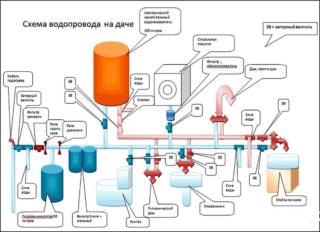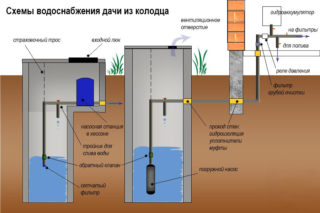To create a reliable plumbing system in the country, you must first make a well with your own hands or hire specialists. Before using water from such a source, it is important to verify its quality. And then draw up a detailed project of the future water supply system, make sure that you have the necessary tools and start the task without haste.
Features of supplying the cottage with water from a well

The well system has many advantages against the background of a small number of disadvantages:
- the possibility of using a large diameter shaft for the installation of submersible pumps;
- the availability of manual water lifting in the absence of electricity;
- the minimum rate of silt formation and sand introduction with the correct construction of the well;
- the possibility of self-cleaning the well, as opposed to the need to call specialists to service the well;
- the ability to independently preserve the system;
- the minimum amount of salts and iron in the water from the well.
However, well water can be contaminated with feces, fertilizers, rot molecules, bacteria, so it is forbidden to refuse to use the filter.
Summer and winter water supply from the well
When organizing a water supply system from a well, it is important to consider the conditions under which the water supply will be used. For the winter system, the mandatory requirements will be:
- laying at a slope towards the well under the level of freezing of the earth;
- use of thermal insulation for the well and pipes;
- the use of a water heating cable along the water supply.
Summer schemes do not require such strict attention. The pipes can be installed directly on the ground or in a small recess. You can use flexible hoses, which are dismantled after the summer season and stored in the closet or subfield.
Country water supply project
To determine all points, you need to walk around the site, measuring all important elements with a tape measure. With this approach, you can pinpoint the position of adapters, couplings, and fittings.
Consumption points consist of the following elements:
- outside the house - installation of hydrants for irrigation;
- inside the house - the use of a hydraulic accumulator and plumbing;
- separate elements - taps in the bathhouse, summer kitchen.
It is best to choose places for the ground system that correspond to the position of paths, ditches, fences. If underground works are planned, they must be calculated together with the specialists who will carry them out.
When planning, it is important to determine how deep the trenches will be. For a summer water supply on a flat area, the depth reaches 40 cm, and on an uneven area - up to 80 cm. Winter water supply can lie at a depth of 2-3 m or more.
Also, the plan should have a common water drain point, which is necessary for the procedure for the conservation of the water supply system. There should be free access to it. Conservation is carried out for the winter.After drawing up the plan, you can proceed to purchase the missing tools, equipment, and consumables.
Tools, equipment and materials for installation
When the well has already been dug and equipped, you need to pick up accessories for the country water supply. The first required element is a pump:
- surface - used if the depth of the well does not exceed 10 m;
- submersible - can be used in deep springs, it is fixed at the bottom of the well;
- pumping stations - are installed where watering of the garden is required, and the equipment of the house, they are mounted indoors or in protected caissons.
When choosing, it is important to take into account the remoteness of the well from the house.
Thermal insulation for pipes
Insulating materials are essential for the construction of a winter water supply system. To do this, use the following shell segments:
- from mineral wool;
- from foam;
- made of polyurethane foam.
You can install the insulation with your own hands. Its additional advantage is protection against mechanical damage.
Pipes and fittings
For the installation of a water supply system from a well in the country, pipes with a diameter of 32 mm are used. They can be metal-plastic, plastic and metal. The first two options are better suited, since they are easier to handle, more reliable, do not freeze and do not corrode.
You will also need fittings, connecting elements, valves, brackets, taps, strainer, mixers. From the tools it is necessary to prepare a grinder, a perforator, a gas wrench.
System installation steps
- Install pumping equipment. If it is a submersible system, it is lowered to the bottom, following the instructions, if it is stationary, it is placed in a utility room.
- Installation of a water intake pipe. Dig a trench, focusing on the type of water supply. At the same stage, a hole is made in the well pipe using a perforator.
- Installation of pipes. Before laying the system, each pipe is “dressed” in thermal insulation selected at the stage of planning and purchasing the elements.
- Connection of a pipe to a well. A hole is made in the well shaft and the pipe is lowered into it almost to the very bottom, leaving a distance of 25-35 cm to it. At this stage, water must be completely removed from the well.
- Fixing the pipe to the bottom. A pin is installed in the well, to which the water intake pipe is attached, having previously installed a mesh filter on it. Next, the inlet in the well is sealed using a sealant or tile adhesive.
- Trench filling. After laying the water intake pipe, fill up the trench. At the same stage, a water heating cable is laid, if used.
- Installation of a pumping station. The pipes are connected to the station, a coarse filter and a valve are placed in front of the inlet, and a fine filter, a pressure switch and a pressure gauge are placed at the outlet.
The next stage requires the dilution of the water supply system at the points of fluid intake. With the help of a grinder, pipes are cut, fittings and seals are connected, ferrules with nuts on points are installed.
All pipes are laid at an angle relative to the place where the water is drained. Therefore, they begin installation from the bottom up - from the lowest to the highest point on the site.
Possible errors and their correction
Most often, problems occur during the construction of a water supply system from an already existing well. It is best to make the source right away with piping.
Another mistake is building at the wrong time of the year. It is better to carry it out in spring or summer, when the water level is at a minimum level, and the soil has not yet taken on a layer of permafrost.
Despite the high cost of the accumulator, its use is mandatory. This is the only way to improve the quality of service of the system and to avoid any malfunctions in the future.










